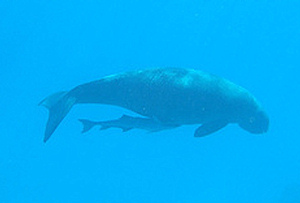The dugong is a large marine mammal which, spans the waters of at least 37 countries throughout the Indo-Pacific, though the majority of dugongs live in the northern waters of Australia.
The dugong has a fusiform body with no dorsal fin or hind limbs, instead possessing paddle-like forelimbs used to
manoeuvre. It is heavily dependent on seagrasses for subsistence and is thus restricted to the coastal habitats where they grow. Its snout is sharply downturned, an adaptation for grazing and uprooting benthic seagrasses.
Dugongs are generally found in warm waters around the coast with large numbers concentrated in wide and shallow protected bays. Large numbers also exist in wide and shallow mangrove channels and around leeward sides of large inshore islands, where seagrass beds are common. They are usually located at a depth of around 10 m.
Although they are social animals, they are usually solitary or found in pairs due to the inability of seagrass beds to support large populations. Gatherings of hundreds of dugongs sometimes happen, but they last only for a short period of time. Because they are shy, and do not approach humans, little is known about dugong behaviour.
Recent population estimates indicate that the area in and around the Bazaruto Archipelago National Park in Mozambique retain a dugong population of about 200 individuals.
See WikiPedia for more information.





